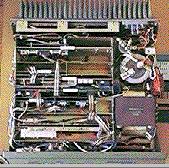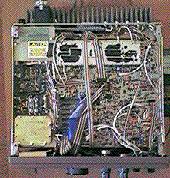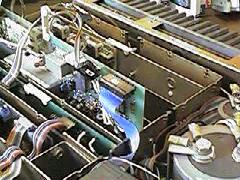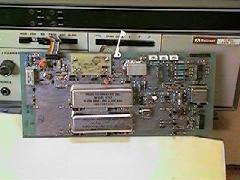


The KWM-380 was released about 20 years ago. I remember that it appeared on the cover of a JA ham magazine when I was a junior highschool student (it might be an HF-380, military version).
I heard good reputations of S-line and the KWM-2A quite some time, but not much of the KWM380 probably because only few JAs had it, which is the only all-solid-state amateur equipment from Collins. And this model is the last amateur rig from the company.
But a few years ago when I read an article by JA7SSB on the KWM-380 in now discontinued JA magazine called "Ham Journal" the radio suddenly attracted my attention. The author who repaired and tested a KWM-380 concluded the article by saying "Pro-mark. What a proud name they gave to it!"
Now, 20 years after its first production, I thought I could afford to purchase a used one and checked some advertisement and classifieds. But I only found it was still too expensive for me.
One day in early 1998 some non-working but inexpensive KWM380s were on sale and I ordered one of them. I didn't have much experience in reparing radio equipments but I believed I could somehow fix it and at least it was worth trying. The unit was being shipped from US and the shop said it took about a month. While waiting I ordered a service manual from W7FG Vintage Manuals and even got a used oscciloscope(!) for repair work. But it was broken physically when it arrived in Japan, and the shop offered another 380 in working condition. It was a bit more expensive than the non-working one but it was still fairy inexpensive. So finally I decided to purchase it.
When I received my unit it was rather heavy (about 45-50lbs) and large. I lived in my company's domitory (only one bed room and small) in Yokohama then. I put the radio on a small desk and used it for a week or two. It seemed to work normally at the beginning but soon I noticed the annomaly. After about 30 minute warmup, S-meter suddenly scaled out for a few times and then it never went dowm below S-3. At first I was disappointed about it but on second thouthts, I said to myself "I intended to fix a non-working one and got an oscope. OK, I'll try and bring it back to life."
A friend of mine who was a professional engineer advised me that there might be an osccilating circuit in the receiver. I inspected the radio for a month and finally found that the VXO circuit in PBT board oscillated falsely (of course VXO must oscillate but in desired frequncy only :-). The culprit was one bypass ceramic capacitor. I replaced the part and now it works fairly well. The oscciloscope was very useful and I enjoyed finding and fixing the problem.

extracting PBT board

PBT board. SSB/CW filter are on the board. VXO circuit is at the bottom right.
I like the recovered audio of the receiver though a bit hissy (audio LPFs like the one introduced in SB-11 might be a help). I also like simple controls but found that changing between avilable tuning steps for scannig is not so convenient.